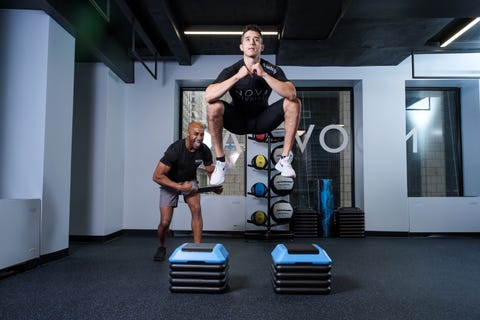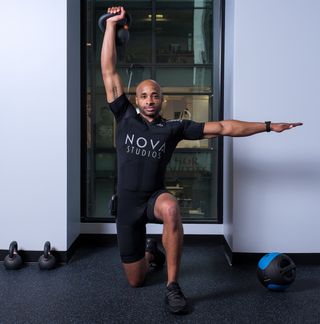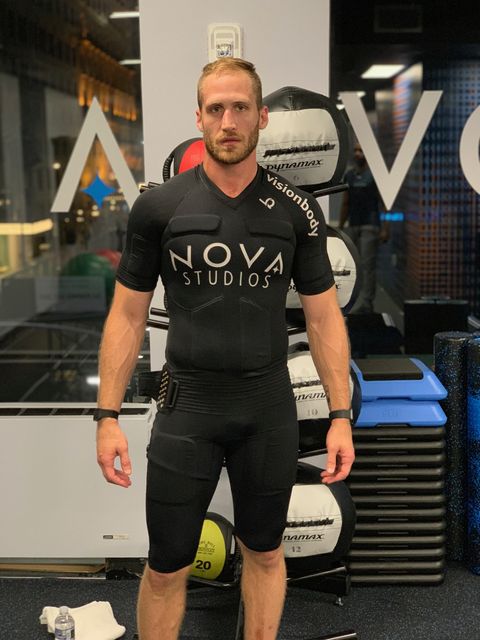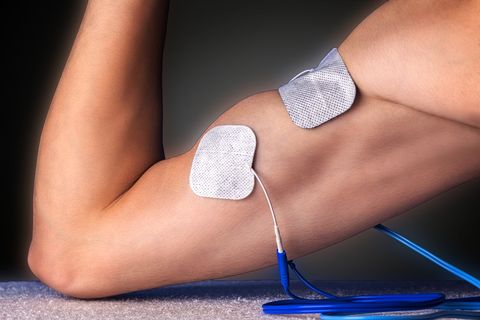
Sweat streamed down my face as I dropped to the floor, ditching the medicine ball from the last round of woodchops to move on to mountain climbers. The high-octane routine wasn’t what pushed me to the brink of my conditioning, though — the extra kick came from the surges of electricity crackling into my stomach, back, and glute muscles through the high-tech, skintight Visionbody suit I was wearing.
I was at Nova Fitness Studios, a new gym in Manhattan, trying out electrical muscle stimulation (EMS) training. This entails attaching a network of electrodes to your body — in this case, via the suit. Then, a trainer zaps you with electricity to stimulate even more muscle activity than usual as you exercise.
Proponents of the futuristic workouts claim that the method leads to seriously impressive results in short periods of time. Nova purports that the suits can reach up to 90 percent of muscle activation per session, allowing wearers to perform reap the benefits of a comparable hour-long workout in 30 minutes or less. Nova’s Visionbody kits are totally wireless, unlike the Miha Bodytec EMS unit Men’s Health Fitness Director Ebenezer Samuel tested last year, so I decided to give the workout a try.
View this post on Instagram
🗣WE’RE ONE DAY AWAY FROM OUR GRAND OPENING! 🕒 Click the link in our bio to book your appointment today! #NOVAFit #GrandOpening . . . #Fitspiration #FitFam #NYCFitness #EMSFitness #FitnessStudio #NOVAFitness #Workout #Gym #Exercises #ExerciseVideos #FitnessVideo #NYC
A post shared by NOVA Fitness Innovation (@novafitnessstudios) on
I felt the buzz of the electrodes even while I was cycling through the toughest moves, as the pulses blasted my chest, stomach, and especially my rear end. It wasn’t painful, exactly — but I was aware of my muscles working through the added strain.
EMS Training: A Different Tool
Jackie Wilson, CPT, the gym’s founder, led me through the workout, which would’ve been tough even without the EMS zaps. An assistant trainer alongside him monitored a tablet that displayed a read-out of the suit’s network of electrodes, tuning up or turning down the juice as needed.

Wilson has been a trainer for 18 years, and he’s used EMS methods for the past two. He believes the methods allow his busy New York City clients to squeeze more results from shorter sessions. “People like that they’re getting their time back,” Wilson said. “You’re out of here within the lunch hour.”

The workouts consist of mostly short, functional circuits. Wilson doesn’t mix Olympic lifts with EMS training, since an electric pulse could throw off someone’s form while their back is loaded with a heavy barbell.
Does EMS Training Work?
The EMS suit definitely had my muscles tingling, but I wasn’t sure how effective it actually was. I turned to physical therapist Rachel Tavel, PT, DPT, CSCS, for some answers. Tavel uses EMS technology in her own practice — but she’s not totally convinced that everyone should be shimmying into the skintight suits for workout sessions.

Getty ImagesIván Jesús Cruz Civieta
Tavel’s main concern is that EMS technology is typically used to rehabilitate one targeted area of the body in a controlled setting. “Use of EMS in a gym setting adds many variables, so it’s hard to know if the treatment is as effective as the claims,” she said.
She also noted that people sold on the quick-hit benefit of EMS-aided workouts could wind up losing out on potential gains. “We shouldn’t necessarily be trying to shorten the amount of time we exercise,” Tavel said. “Shortening the time we exercise means lengthening the time we aren’t exercising. If anything, a shorter workout might lead to increased time sitting afterwards.”
That said, Tavel pointed to a study that supports the use of EMS for muscle stimulation in some settings, and ultimately hopes that the techniques catch on — so long as there’s real research supporting the claims.
“If technology such as EMS can be prove to be beneficial in helping boost the effectiveness of our own workouts, then I’m all for it,” she said. “But it shouldn’t reduce the amount of exercise people do on their own.”
As bullish as he is on the tech, Wilson agreed that EMS training can only do so much, and other workouts are needed for a well-rounded regimen, too. Wilson insists that his clients take at least one day between sessions to avoid burnout, since the suits have such an intense effect on the body.
“You’re still relying on outside factors,” he said. “Are you eating the way you’re supposed to? What are you doing on days you’re not with us [training with the suit]?”
Final Thoughts
I enjoyed the electrified sweat session, and my lower body muscles were sore for several days afterwards, which made me feel like the time was well-spent.
But I don’t think I’ll be switching to EMS training on a full-time basis. Whether the benefits are real or not, I love working out too much to even think about cutting down my time in the gym.
Source: Read Full Article
